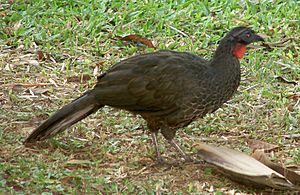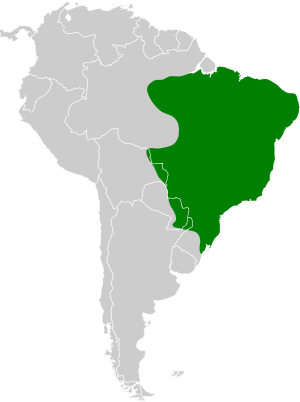Rusty-margined guan facts for kids
Quick facts for kids Rusty-margined guan |
|
|---|---|
 |
|
| Conservation status | |
| Scientific classification | |
| Genus: |
Penelope
|
| Species: |
superciliaris
|
| Subspecies | |
|
|
 |
|
The rusty-margined guan (Penelope superciliaris) is a type of bird that lives in parts of South America. It belongs to a bird family called Cracidae. This family also includes birds like chachalacas, other guans, and curassows. You can find the rusty-margined guan in countries such as Argentina, Bolivia, Brazil, and Paraguay.
Contents
About the Rusty-Margined Guan
How Scientists Classify Them
Scientists group living things based on their shared features. This is called taxonomy. The rusty-margined guan has a few different types, called subspecies. These are like slightly different versions of the same bird. Most scientists agree there are four main subspecies. One group, the Clements taxonomy, groups one of these subspecies with another.
What They Look Like
The rusty-margined guan is a medium-sized bird. It can be about 55 to 73 cm (1.8 to 2.4 ft) long. Its weight can vary, with some birds weighing around 950 to 1,150 g (2.1 to 2.5 lb).
These guans are mostly dark olive or brownish on their upper parts. They have reddish edges on their wing feathers and shoulders, which is how they get their name "rusty-margined." Their belly also has a rusty color. Their face is light, and they have a stripe above their eye called a supercilium. This stripe can be white, light yellow, or a reddish-yellow color depending on the subspecies. Some subspecies are lighter overall, while others are darker.
Where They Live
The rusty-margined guan lives in many different places across its large home range. You can find them inside and at the edges of thick forests. They also live in forests along rivers, in coastal woodlands, and in areas with scattered trees within grasslands. They can even be found in dry shrublands and mangrove swamps. Sometimes, they live in tree plantations too.
These birds usually stay in lower areas. However, in some parts of Brazil, they can be found as high as 1,300 m (4,300 ft) up in the mountains.
Rusty-Margined Guan Behavior
How They Move
Rusty-margined guans generally stay in one area and do not travel far. In some places, they might sleep in higher spots and then move down to lower areas to find food. This change in height can be up to 400 m (1,300 ft). They do not fly very often or very far. When they do fly, it's usually less than 20 m (66 ft).
What They Eat
Rusty-margined guans look for food alone, in pairs, or in small groups of up to 10 birds. They mostly find their food about 5 and 10 m (16 and 33 ft) above the ground. However, they also often search for food on the ground. Their diet is almost entirely fruit. One study found that they eat fruit from 117 different kinds of plants! They also eat small amounts of flowers, leaves, and insects.
Reproduction and Life Cycle
The breeding season for the rusty-margined guan happens at different times depending on the location. In Argentina, it's from October to February. In southeastern Brazil, it's from August to February. Scientists are still learning about their breeding times in other areas.
They build their nests in trees. The nest is a platform made of sticks and lined with both fresh and dry leaves. Female guans usually lay three eggs at a time.
Sounds They Make
The rusty-margined guan makes a special sound with its wings, which is called a "wing-whirring display." It also makes a "gruff barking" call. This call is probably used as an alarm to warn others of danger, but it might be used in other situations too.
Conservation Status
The IUCN (International Union for Conservation of Nature) has listed the rusty-margined guan as "Near Threatened." This means that while it's not in immediate danger of disappearing, its population could become threatened in the future. It is only fairly common in areas that are protected. Even in these protected places, people sometimes hunt them illegally, which is a concern for their survival.
See also
 In Spanish: Pava chica para niños
In Spanish: Pava chica para niños


